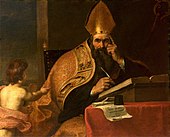Harmony of the Gospels
| Part of a series on |
| Augustine of Hippo |
|---|
 |
| Augustinianism |
| Works |
| Influences and followers |
| Related topics |
| Related categories |
|
The Harmony of the Gospels (
Synopsis
The Harmony of the Gospels is divided into four books. The first book is an extended argument against pagans who claim that Jesus was nothing more than a wise man, and claim that the writers of the Gospels changed his teachings, especially regarding his divinity and the prohibition of worshiping other gods.
The other three books are an examination of the four Gospels, using the Gospel of Matthew as a basis, since Augustine believed that it was written first.[3]: 157 In Book II, he compares the other three Gospels to Matthew from the beginning through the Last Supper. He continues this comparison in Book III from the Last Supper until the end of the Gospels. In Book IV, he examines the stories in the other Gospels that have no parallel in Matthew.[5]
Despite its name, the Harmony of the Gospels is not a full
Methods
In his comparison of the Gospels, Augustine made use of the
Augustine used various methods to resolve the contradictions he found. Some he resolved by pointing out historical information. For example, to those who wonder how Herod can be alive at Jesus' baptism when he died before Jesus returned from Egypt, Augustine pointed out that those were two different Herods, one of which is the son of the other.[3]: 159
Other times, Augustine tried to solve contradictions by a linguistic analysis, such as showing how one word can have two different meanings, or, alternatively, two different words can mean the same thing.[10]: 151–152 What mattered to Augustine is the meaning that the Evangelist was trying to get across, and not the exact words he uses; differences in words do not matter when the Evangelists clearly intend the same thing.[10]: 158 However, his lack of expertise in the original Greek sometimes undermines his linguistic analysis.[3]: 159
Augustine also made use of
In situations where the details in the various accounts differ from each other and cannot be reconciled, Augustine held that two distinct albeit similar events or speeches were being recorded; alternatively, if the details differ but do not conflict, that the different evangelists simply chose to note down different details.[3]: 160 [10]: 145 For example, when Mark relates Jesus healing a blind man while leaving Jericho and Luke tells of him healing a blind man while approaching Jericho, Augustine considered these to be two separate miracles.[4]: 33 However, Augustine only resorted to this method if he could find no other solution.[4]: 34
However, when the same events are related in different orders, Augustine held that the order in which the events are narrated are not necessarily the order in which they happened; sometimes the writers narrate events out of order.[11] This difference in order is only a contradiction if the writers intended them to be in the actual order of occurrence.[4]: 31
Relationship between the Gospels
In Book I of the Harmony of the Gospels, Augustine initially upheld the then-traditional view that the Gospels were written in canonical order – that is, Matthew first, followed by Mark, then Luke, then John.[6]: 38 However, while the traditional view held that the four Evangelists wrote independently of the others using Apostolic tradition, Augustine departed from this tradition by claiming that each was aware of and made use of the preceding Gospels, a view which seems to be his own innovation.[4]: 16–17 This view as it pertains to the first three Gospels (the Synoptic Gospels) is now commonly known as the Augustinian hypothesis,[12]: 86–87 which became the consensus view for 1,350 years.[13]: 489
In Book IV, however, he put forth a different view. He claims that it is "more probable" that Mark wrote after Luke, making use of both Matthew and Luke in the composition of his Gospel, a position that is now called the
Augustine also noted that each Gospel has its own overall emphasis: Matthew focuses on Jesus' royalty, Luke deals with his priesthood, and John with his divinity, while Mark, also dealing with his royalty, gives an abbreviated version of Matthew.[2] In the same place, Augustine interprets the four living creatures of Ezekiel and Revelation as the Four Evangelists: Matthew being the lion, Mark the man, Luke the ox, and John the eagle.[12]: 85
References
- ISBN 0-8028-3843-X.
- ^ ISBN 978-1-61097-625-1.
- ^ ISBN 0-8204-2292-4.
- ^ ISBN 978-0-8028-4054-7.
- ^ a b Schaff, Philip, ed. (1956). Saint Augustin: Sermon on the Mount; Harmony of the Gospels; Homilies on the Gospels. Eerdmans. p. 71.
- ^ ISBN 0-86554-087-X.
- ISBN 978-0-300-09839-6.
- ISBN 978-0-664-22587-2.
- ^ ISBN 978-0-19-880260-0.
- ^ S2CID 162717198.
- ISBN 0-8204-2292-4.
- ^ ISBN 9780801049507.
- ^ ISBN 978-0-8308-2927-9.
External links
 The full text of Harmony of the Gospels at Wikisource
The full text of Harmony of the Gospels at Wikisource
